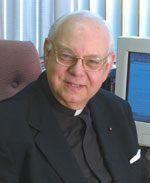Easter, Feast of the Resurrection of the Lord /
Msgr. Owen F. Campion
The Sunday Readings
 The Church celebrates the Easter Vigil late in the evening on Holy Saturday. The liturgy for the Easter Vigil has its own set of readings.
The Church celebrates the Easter Vigil late in the evening on Holy Saturday. The liturgy for the Easter Vigil has its own set of readings.
These readings are those read during Masses on Easter Sunday.
The Acts of the Apostles provides the first lesson.
Acts is, in effect, a continuation of St. Luke’s Gospel. Scholars say that the Gospel of Luke and the Acts of the Apostles were the work of the same author.
Beginning with the Ascension, Acts reports what life was like for the infant community of Christians in Jerusalem then recalls the initial spread of Christianity.
Important in the early chapters of Acts is a series of sermons delivered by Peter. The place of Peter is interesting, and revealing to anyone concerned about the structure of the Church then or now.
Always, Peter spoke for the Apostles and for the Christian community.
In this Sunday’s reading, Peter briefly gives a synopsis of the life of Jesus. Sent by God, Jesus was crucified, the victim of human scheming. He rose after death. He commissioned the Apostles to continue the work of reconciling God and humanity. The Apostles were witnesses of all that Jesus did.
The Epistle to the Colossians, the second reading, places Christ at God’s right hand.
It says that Christians already have “been raised” because they have taken Christ into their hearts. Having given themselves to Jesus, they have died to earthly things and to earthly ideas.
St. John’s Gospel, the source of the last reading, goes into some detail about the Resurrection and its aftermath.
The first figure mentioned in the story is Mary Magdalene. She was a beloved figure in early Christianity because she was so intensely loyal to Jesus.
According to John’s Gospel, Mary Magdalene stood beneath the cross of Calvary rather than abandon the dying Lord. It was a risky gesture. She might have been construed to be an accomplice in treason against the Roman Empire, subjecting herself to the same fate as that of the Lord. Yet she was there with Jesus.
Her loyalty is demonstrated again when, after arriving at the tomb before daybreak, Mary Magdalene finds it empty then hurries to tell Peter and the disciple whom Jesus loved.
Tradition has assumed that this disciple is John even though he is never identified by name in this Gospel.
Peter and the disciple then rush to the tomb, where they are overwhelmed. Grasping what exactly has happened at the tomb was not easy for them. Love and faith made the process easier. After seeing that the tomb was empty, they believed that Jesus had risen.
Reflection
The Church joyfully and excitedly tells us that the Lord lives. Jesus rose from the dead. It is a proclamation of the greatest and central belief of the Church, namely that Jesus, the Son of God, overcame even death.
However, the lesson is more than simply to affirm once again the Church’s trust in the resurrection—actual and physical—of Christ. It calls upon us to respond.
Such was the message in Colossians, the second reading. And such is the important lesson in the references to Mary Magdalene, Peter and the disciple whom Jesus loved. They had to believe. They had to have faith.
We must be open to God ourselves. Limited and bruised by sin, we must be healed and strengthened to receive the grace of faith. Hopefully, Lenten penances these past weeks have healed and strengthened us, and made within us this openness.
In the meantime, the Church shares with us the testimony of Peter and the Apostles, not just bystanders as the mission of Jesus occurred, but rather the Lord’s especially commissioned agents to tell us about our own salvation.
Their testimony, so guarded by the Church, is our avenue to knowing and meeting the Risen Christ. †
 The Church celebrates the Easter Vigil late in the evening on Holy Saturday. The liturgy for the Easter Vigil has its own set of readings.
The Church celebrates the Easter Vigil late in the evening on Holy Saturday. The liturgy for the Easter Vigil has its own set of readings.